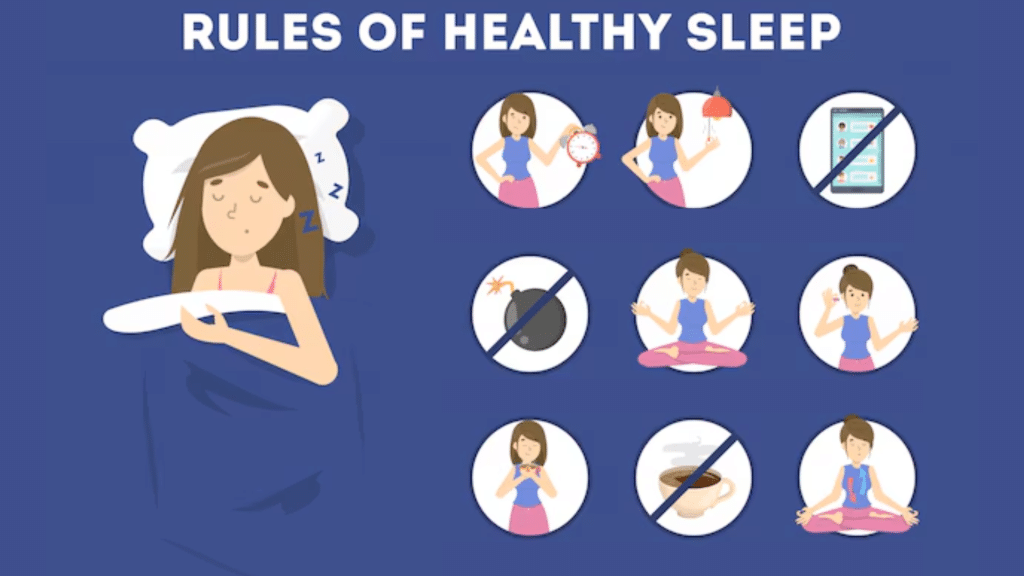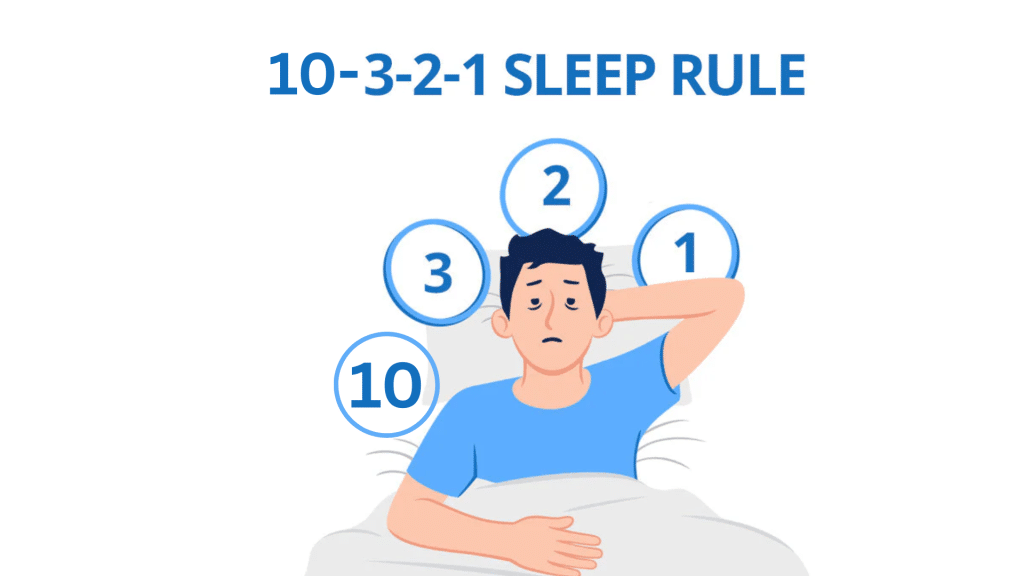Ever feel like you’re doing everything right but still can’t fall asleep easily, or you wake up tired anyway? I’ve been there, and the truth is, what you do in the hours before bed can make or break your rest.
That’s where the 10-3-2-1-0 sleep rule comes in. It’s a simple countdown that helps you cut out habits that keep you awake and replace them with ones that help you wind down.
I’ll walk you through exactly what the rule is, why it works, and how to make it fit your life. By the end, you’ll have a clear, step-by-step routine you can start tonight. Let’s lead you to a deeper, better sleep.
Understanding the 10-3-2-1-0 Sleep Rule?
The 10-3-2-1-0 sleep rule helps you sleep better by cutting certain habits at set times before bed.
Ten hours before bed, you stop having caffeine. Three hours before bed, you stop eating food or drinkingalcohol. Two hours before bed, you stop doing any work. One hour before bed, you turn off all screens. And in the morning, you don’t hit snooze.
It’s a simple countdown that makes it easier to build a calm and healthy sleep routine night after night.
Where the Rule Came From
This routine gained popularity among doctors and wellness experts who sought to simplify sleep hygiene.
It’s unclear who exactly created the 10-3-2-1-0 method, but it has been widely shared by health websites, podcasts, and sleep specialists.
It caught on because it breaks sleep prep into a simple, doable daily routine. Instead of vague advice like “get better sleep,” it tells you what to stop doing, and when, to give your body the chance to wind down naturally.
Why It Works for Better Sleep
The rule works because it follows the way your body and brain naturally prepare for sleep. It avoids things that overstimulate your mind, like caffeine, work, food, and screens, while giving you time to slow down.
The countdown format makes it easier to remember and stick with each step. When you repeat it daily, it helps you fall asleep faster and wake up feeling more refreshed. It’s all about creating rhythm and routine.
Detailed Breakdown of Each Step

This rule works best when each step is followed as a steady wind-down routine leading up to a restful night’s sleep.
10 Hours Before Bed: Cut Caffeine
Caffeine can stay in your body for up to 10 hours, making it harder to fall or stay asleep. Even if you don’t feel wired, caffeine can reduce the quality of your sleep without you noticing. It’s not just coffee, soda, energy drinks, chocolate, and even some pain relievers that have caffeine in them.
Start checking labels and choose non-caffeinated options later in the day. If you love an afternoon drink, try herbal tea or decaf instead to avoid disturbing your body’s sleep rhythm.
3 Hours Before Bed: Stop Eating and Drinking Alcohol
Eating late can confuse your digestion and keep your body too active when it should be slowing down. Alcohol may make you feel sleepy, but it interrupts deep REM sleep and can cause you to wake up throughout the night.
If you’re hungry before bed, a small snack like a banana or plain yogurt might be okay, but avoid heavy or spicy meals. Drinking water is fine, but cut alcohol to give your brain and body a better chance to rest.
2 Hours Before Bed: Stop Working
Working too close to bedtime keeps your brain active and alert when it should be slowing down. Tasks like emails or planning tomorrow’s to-do list can raise stress and make it harder to fall asleep.
Your mind needs time to switch gears from “doing” to “resting.” Try ending work with a short transition routine like stretching, tidying your space, or making tomorrow’s checklist early. These small steps help you mentally shut down and tell your brain it’s time to relax.
1 Hour Before Bed: Turn Off Screens
Screens give off blue light, which tricks your brain into thinking it’s still daytime. This light blocks melatonin, the hormone that helps you feel sleepy. Turning off phones, TVs, or laptops an hour before bed helps your body get back into a natural rhythm.
Instead of scrolling, try something quiet and low-light like reading a paperback, listening to soft music, or writing in a journal. These activities send clear signals to your brain that it’s time to rest and slow down.
0 Snoozes in the Morning: Why It Matters
Hitting the snooze button might feel good in the moment, but it actually leaves you groggier. This is because your body restarts a sleep cycle it can’t finish. When you snooze, you wake up at a later stage of sleep, which can make you feel more tired than if you had gotten up the first time.
To avoid this, place your alarm across the room and try to get sunlight as soon as possible. Getting up right away helps your body feel more alert.
Benefits of Following the Rule
This sleep rule helps train your body and mind to relax on time, which leads to deeper, better-quality rest. Here are the benefits it offers:
Fall Asleep Faster and Stay Asleep
By avoiding things that keep your brain and body alert, like caffeine, screens, and work, you give yourself a better shot at falling asleep quickly. Your internal clock learns when it’s time to wind down.
Over time, your sleep becomes steadier, and you’re less likely to wake up in the middle of the night. It’s a simple shift that helps your natural sleep cycle work the way it’s supposed to, without needing medicine or drastic changes.
Wake Up Feeling More Rested
Skipping the snooze button and getting quality sleep throughout the night helps you wake up feeling more alert. Instead of dragging through the morning in a fog, your brain gets the full rest it needs.
Following the full routine allows your body to go through full sleep cycles, making your mornings smoother and more clear-headed. A better wake-up leads to a better day, without needing extra coffee or naps to keep going.
Build a Consistent, Healthy Routine
The 10-3-2-1-0 rule isn’t just about sleep; it’s about creating habits that improve your whole day. When your nights become more predictable, so do your mornings. You’ll find it easier to plan meals, finish work on time, and stick to a calm bedtime schedule.
That kind of structure makes it easier to keep other healthy habits, too. Small daily steps add up to a routine that feels steady, not rushed or stressful.
Lower Stress and Anxiety at Night
This rule gives your brain time to shift from busy thoughts to rest mode. Cutting off work and screen time before bed helps quiet racing thoughts. Without last-minute emails or endless scrolling, your body starts to slow down naturally.
That calm feeling reduces anxiety and helps you sleep more peacefully. The more often you follow the routine, the easier it gets to relax at night, without lying awake worrying or feeling overwhelmed.
How to Start Using the Rule in Daily Life

You don’t need to be perfect to benefit from the 10-3-2-1-0 sleep rule; just start small and build from there. Start with simple steps, such as cutting caffeine early and turning off screens before bed. Once that feels easy, add the rest.
You can write the rule on a sticky note or set phone reminders to guide you. If you forget or miss a step, don’t stress. Just try again the next day. The key is progress, not perfection.
Over time, your body will adjust, and the routine will feel more natural. Making sleep a priority takes practice, but this rule gives you a clear path. Stick with it, and you’ll likely feel the difference within a week or two.
Adapting the Rule to Fit Your Lifestyle
You don’t need a perfect schedule, just adjust each step to match your sleep time, work hours, and daily responsibilities. Here’s how to tailor it to your specific needs:
Shift Workers (Night or Rotating Schedules)
For shift workers, the countdown starts before your main sleep period, no matter what time that is. Replace “bedtime” with your usual sleep time and follow the rule backward.
Use blackout curtains and white noise to block out daytime disruptions. Try to keep your sleep and wake times consistent, even on off days. Sync your habits with your unique work pattern to help your body rest when it needs to.
Parents with Young Kids
Parenting can interrupt even the best sleep plan, so aim for flexibility over perfection. Follow the rule when possible, but don’t worry if you miss a step. Focus on repeating the same bedtime habits so your body learns the rhythm.
A shorter version of the routine is better than none at all. Over time, even small moments of calm before sleep can help you feel more rested and in control.
Students and Night Owls
If you go to bed late or have irregular hours, start by shifting your bedtime earlier in small steps. You can still follow the countdown from your current sleep time. Turn off screens, skip caffeine, and do some quiet reading to wind down.
If study sessions run late, do what you can; partial effort still helps. With regular use, your body will slowly adapt and respond better to the routine.
Common Mistakes to Avoid
Some habits might seem harmless, but they can prevent this rule from working well. Here are a few to watch out for:
- Trusting “Night Mode” instead of shutting off screens: Blue light filters help a little, but full screen-free time is better.
- Thinking it’s a quick fix: The routine works best when used daily, not just once in a while.
- Snoozing every morning: Repeatedly hitting snooze confuses your sleep cycle and makes waking up harder.
- Skipping steps too often: Missing one occasionally is okay, but regular skips weaken the benefits.
- Not adjusting the rule to your lifestyle: One size doesn’t fit all; it’s fine to tweak it.
- Expecting instant results: It takes time for your body to adjust and respond to the routine.
- Ignoring other sleep needs: Room temperature, noise, and stress all matter too; this rule is just one part.
Keep these in mind, and you’ll give the 10-3-2-1-0 sleep rule the best chance to work for you. Small, consistent changes add up, and your future, well-rested self will thank you.
Conclusion
The 10-3-2-1-0 sleep rule gives you a clear, no-guesswork way to wind down at night. By cutting out late-day caffeine, avoiding screens before bed, and skipping the snooze button in the morning, you’re giving your body the best shot at sleeping deeply and waking up with more energy.
I’ve found that even small nighttime changes can make a big difference in how you feel the next day. Start with what feels doable and adjust as you go, you’ll notice the benefits sooner than you think.
Want more simple, real-life ways to sleep better? Take a look at my other posts for tips that help you rest easier and feel refreshed every morning.









